When was the last time a Buffalo Sabre won something significant?
No, really think about it. For the better part a decade, the Sabres have bumbled around the bottom of the standings, trudging their way to losing season after losing season. The only real recent “win” is the Draft Lottery in 2018 and having the opportunity to draft Rasmus Dahlin first overall. That win will start to pay off this season.
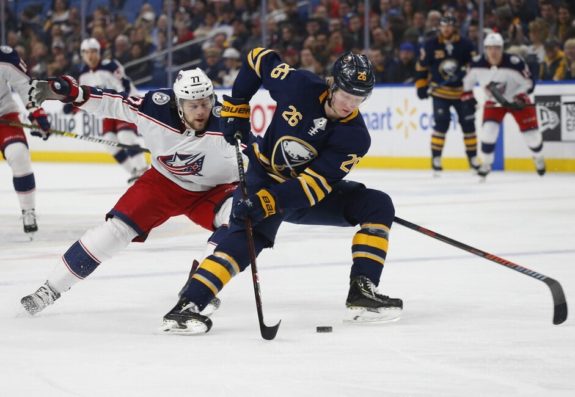
It’s time to start building some good mojo going into this season. Let’s look ahead and predict the winners of our own awards. Some will be positive, others not so much. In any event, there is hardware to be had.
Most Likely to Break Out
The Sabres desperately need a breakout performance. This season, one player in particular is poised to do just that: young, 23-year-old Sam Reinhart. ‘Hasn’t he already had a breakout season?’ some may wonder. After last season’s 65-point output, it would be reasonable to conclude that.
Reinhart has seen his point-per-game average increase each season, averaging 0.53, 0.59, 0.61 and 0.79. Last season was his strongest campaign to date but there is still room for improvement. The power play, in particular, has the potential for growth.
Reinhart Has Room to Grow
In 2018-19, Reinhart saw a slight increase in his power play ice time based on his three-season average. However, his power-play points dropped from 18 to 15 and his goals from an average of 8 to 2. If he can be used similarly to his first three seasons, he could easily eclipse 20 points on the man advantage this season.
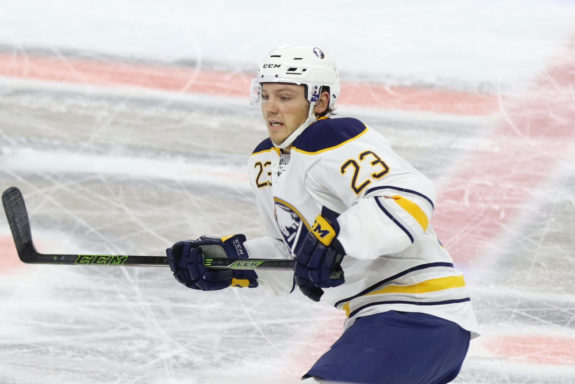
Reinhart could improve with an adjustment to his even-strength deployment. Last season, he was primarily running with offensive dynamos Jack Eichel and Jeff Skinner. There were advantages to playing with those linemates but there were also drawbacks. Given the lack of depth on the Sabres, opposing teams simply threw out their best defenders to shut down the trio.
Sabres fans may not be inclined to separate Reinhart from Eichel. Many feel he is not capable of driving his own line. This is mostly due to the lack of success he had early in his career at centre. Unfortunately, Reinhart’s most common linemates were Kyle Okposo, Zemgus Girgensons, Marcus Foligno and Matt Moulson – not exactly the perfect recipe for creating offense.
Reinhart Ready to Drive a Line
Reinhart has proven himself capable of driving offense on his own. Looking at expected goals-for percentage (xGF%), the majority of players saw their percentages decrease when not playing with him. According to Natural Stat Trick, Eichel went from 54.42 percent to 50.82, Dahlin went from 54.43 percent to 49.32, Rasmus Ristolainen went from 54.05 percent to 44.95 and Brandon Montour fell from 57.64 percent to 49.46.
If first-year head coach Ralph Krueger decides to use Reinhart as a catalyst on the second line for young centreman Casey Mittelstadt, Reinhart could excel. Opposing teams would likely continue to deploy the top defenders against Eichel and Skinner, thus opening up more ice for Reinhart to create chances.
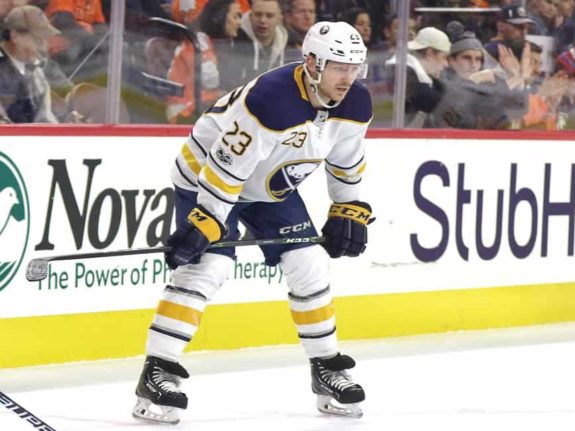
Additionally, this is a contract year for Reinhart. The trend in the NHL is for young players to cash in after their entry-level deals. After signing a two-year bridge contract worth $3.65 million, he will be looking to have the biggest season of his young career.
If Reinhart can see his power-play output return to average, receive better deployment at even strength and have the added motivation of a big payday at the end of the season, he could flirt with 80 points and drive offensefor the Sabres from the right side. Everything could align for him to truly break out in a big way.
Most Likely to Disappoint
After a stellar inaugural season with the Sabres, Skinner feels like the most likely candidate to disappoint. Much of the disappointment will come because of just how great last season was for Skinner. He arrived in Buffalo after a trade at the beginning of August to much fanfare and then shot out of a cannon, scoring 14 goals in his first 20 games, and another 14 in his next 22.
Skinner’s Stellar Sabres Season
Before arriving in Buffalo, Skinner averaged a shooting percentage of 10.93% over his previous three seasons with the Carolina Hurricanes. Last season, he saw his shooting percentage rise to 14.9%, the highest of his career. That contributed to 40 goals, more than 10 over his previous three-season average, despite taking four fewer shots than he averaged in those three seasons.
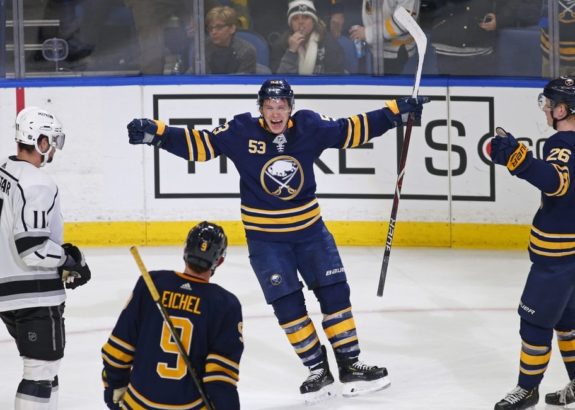
There are various reasons for Skinner to see such increases. In Carolina, he never had a consistent linemate as elite as Eichel. Eichel has the ability to draw defenders toward him, open up ice for his wingers and deliver the puck with precision that lead to scoring chances.
Skinner also saw significant increases in his power-play usage. Last season, he was on the ice for 61.8 percent of the Sabres’ man advantage. His previous three seasons in Carolina, he averaged just 43.23 percent. You can expect his extensive power-play time to continue, and it will benefit him to spend more time with Dahlin, Eichel and Reinhart on the man advantage.
What to Expect From Skinner
While it’s hard to project exactly what the future holds for Skinner given his new deployment in Buffalo and now his new coach, let’s assume he maintains a shooting percentage between what he did last season and what he was doing in Carolina at 12 percent. If he hits his average in shots over the last three seasons of 279, that projects to a 33-goal season. Even if he catches a couple of breaks and pots 35 goals, some Sabres fans will find that a disappointment.
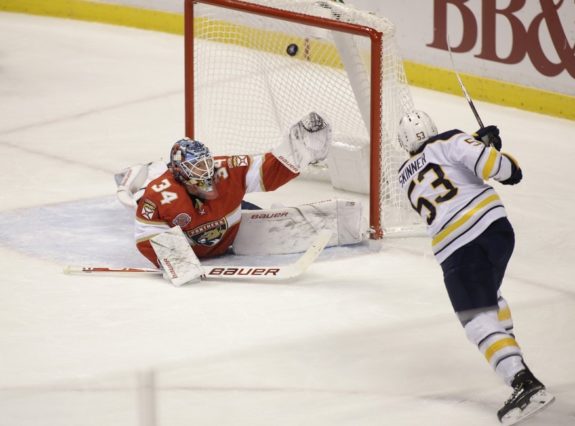
After signing an eight-year, $72-million contract, expectations for Skinner are sky high. He is being paid handsomely to score goals and he should be finishing in the upper echelon of goal-scorers for at least the next three seasons. If he had scored 35 goals last season, he would have finished outside the top 20 in terms of goals scored.
Perhaps last season wasn’t an anomaly and Skinner is truly a goal-scorer. I find it hard to believe he will be a massive disappointment given his overall offensive contributions, but if he finishes with fewer than 40 goals, Sabres fans could begin to question the investment.
Most Likely to Bounce Back
If this award was for the player who must bounce back, the majority of last season’s squad would be the proud owners this hardware. But this is the award for who is most likely to bounce back and the player who seems positioned well for this is Mittelstadt.
Mittelstadt’s Shaky Rookie Campaign
To say that Mittelstadt’s rookie campaign didn’t go as planned would be an understatement considering he was in the preseason Calder Trophy conversation. After trading away Ryan O’Reilly, the Sabres brass felt strongly enough about Mittelstadt’s overall game that they opted to rely on the 19-year-old instead of finding another second-line centre.
After putting up 30 points in 34 games with the University of Minnesota and 11 points in seven games for Team USA at the World Junior Championships in Buffalo, Mittelstadt signed his entry-level contract with the Sabres and appeared in six games to end the 2017-18 season. In those games, he tallied five points, building on the anticipation of Sabres fans and NHL pundits alike.
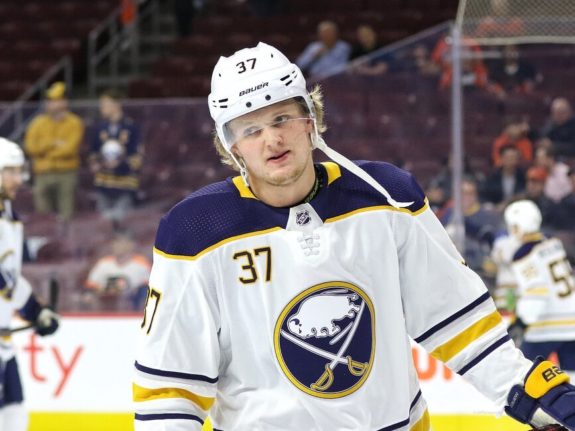
That 68-point pace would not last long. He finished the season with just 25 points in 77 games. He showed flashes of skill and ability throughout the season but most nights he seemed outmatched and overwhelmed during a difficult season.
Mittelstadt may not have been ready for the rigours of playing second-line centre against the most talented players on the planet, but his former coach, Phil Housley, didn’t help him much either.
Mittelstadt Was Not Utilized Properly
His most common forward linemates last season were Connor Sheary, Kyle Okposo and Tage Thompson. None of these three players have the same offensive flair and upside as Mittelstadt. What effect did the three have on each other while on the ice? Let’s look at xGF% for Mittelstadt and each of these three players.
When playing with Sheary, the pair had a 49.28xGF%. While still expected to score fewer than half of the goals, this was the strongest pair that Mittelstadt found among his most common linemates.
With Okposo, they had a 40.22xGF%. Yikes. What’s interesting to note about this pairing is that when Okposo wasn’t playing with Mittelstadt, he had a 47.21xGF%. When Mittelstadt was without Okposo, he had a 46.29xGF%. Though both players were losing, they were losing less when separated.
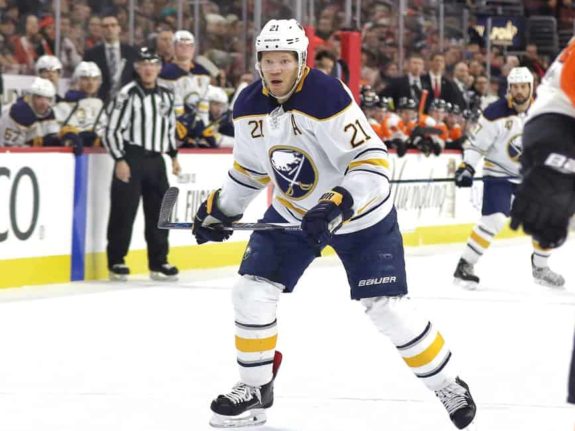
The same is true for the Mittelstadt-Thompson duo. Together, they mustered an abominable 37.15 xGF%. Without Mittelstadt, Thompson still struggled but put up a 42.89xGF%, conceding more than 5% fewer expected goals against. Mittelstadt, for his part, put up a 48.50xGF% without Thompson, over 11 percent fewer expected goals against,
It’s true that Mittelstadt didn’t perform to expectations but he was not put in a position to succeed. Housley’s usage of him and his linemates was to their detriment, and they performed better apart than the abysmal numbers they put up together.
Reasons For Optimism With Mittelstadt
What gives us reason to believe he’ll bounce back? First of all, as we’ve seen, the bounce doesn’t need to be very high. With how low the bar is set after last season, Mittelstadt doesn’t need to shoot out the lights to improve. If he can maintain a 50-point pace, that would double his rookie output and be considered a very successful season.
We don’t know what Krueger’s plan is for Mittelstadt, but if he reads The Hockey Writers and pairs his Most Likely to Bounce Back candidate with his Most Likely to Break Out player, it could help both players reach those heights.
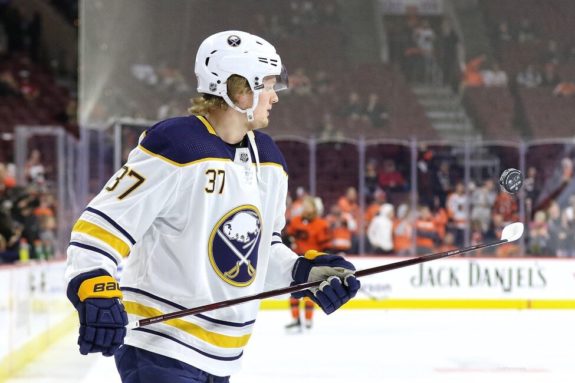
Both players would benefit from facing second-tier opponents. They also complement each other nicely. Reinhart plays a strong possession game where he exits his own zone and enters the offensive zone with the puck consistently. Mittelstadt plays with speed and skill and is able to get to the high-danger areas.
The final piece to complete this trio should be Marcus Johansson. The Sabres’ new addition plays an offensively creative game that is also focused on zone entry and possession.
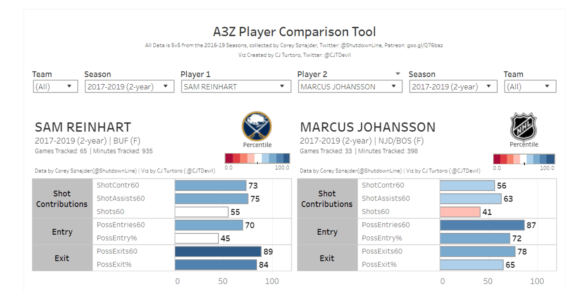
If Mittelstadt has a progressive summer and is able to bulk up and add strength, he could find a great degree of success positioned between Reinhart and Johansson. If he is able to play a larger role on the power play, he could very well reach that 50-point pace.
Most Likely Dark-Horse MVP
Our three award winners are all recipients that, to a degree, we can see coming. For our Dark Horse MVP, the player must be less obvious or even unimaginable. For this season, that player is Linus Ullmark.
The Sabres’ most consistent scapegoat for the past few seasons has been the defense. It’s true that the rearguards struggled but last season, the Sabres’ goaltending is what really brought them down.
Sabres Let Down By Goaltending
After a stellar campaign with the St. Louis Blues, Carter Hutton came to Buffalo on a three-year deal. In his last season with the Blues, he posted a .931 save percentage which fell to just .908 with the Sabres last season. What’s interesting is that according to Corsica, his expected save percentage (xSv%) was .925 with the Blues and .924 with the Sabres. His under-performance led to a goals saved above average (GSAA) of 15.09 with the Blues and minus-3.11 with the Sabres.
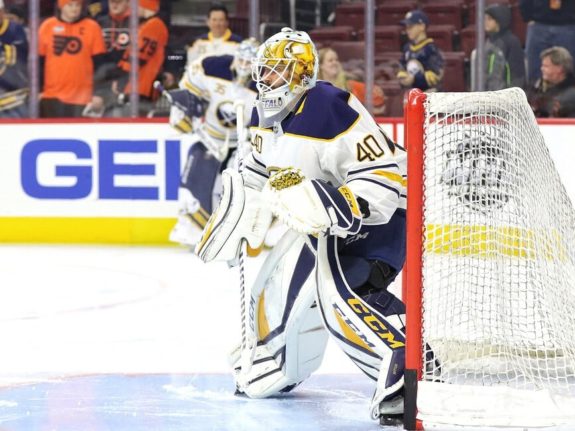
One reason for this precipitous drop could be his usage. In his previous two seasons with the Blues, Hutton averaged 31 games played. His career-high before last season was 40 games played in 2013-14 with the Nashville Predators. As the season wore on and he approached the 50-game mark, his save percentage dropped from .919 at the start to .897 as the curtain fell on the year.
It is in the Sabres’ best interest to keep Hutton to around 30 starts. Doing so, with a capable starter, would give the Sabres two solid netminders to compliment a roster that continues to be overhauled. What gives us reason to believe that Ullmark can be the Dark-Horse MVP?
Ullmark Provides Glimpses of Hope
The 26-year-old is entering a pivotal season. Since being drafted in 2012, Ullmark has been regarded as the eventual heir to the throne in net. To date, such a reality has not come to fruition.
There have been glimpses of what Sabres fans have been hoping for. In 2017-18, he had a solid season with the Rochester Americans. Appearing in 44 games, he finished with 21 victories and a .922 save percentage, propelling the Americans to the Calder Cup playoffs.
Ullmark also appeared in five games for the Sabres that season and finished with a .935 save percentage; it’s a small sample size but he has shown flashes of his ability.
During the summer, Ullmark and the Sabres went through an awkward salary arbitration. He was seeking a contract worth reportedly $2.65 million while the Sabres countered with $800,000. Being $2 million apart on a $10 million player can be challenging, but being that far apart on a player seeking under $3 million makes things very uncomfortable, to say the least.
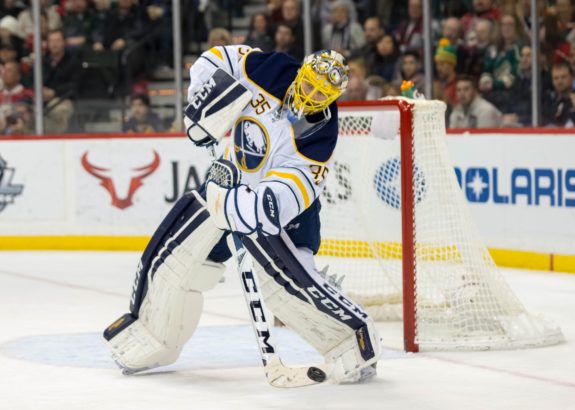
In the end, the two parties settled on a one-year deal outside of arbitration worth $1.325 million. This negotiation taught us exactly where each party is in their relationship.
The Sabres were not impressed with how last season went. Having invested seven years in the development of this player, they are looking for much more. Where Ullmark ranks, as far as they’re concerned, is as an AHL goalie.
Ullmark, for his part, feels that he should be a starter. His ask was $100,000 less than his counterpart who took the Sabres’ crease on 50 occasions last season. He wants to be considered a top young goalie in the league and be compensated accordingly.
A Pivotal Season for Ullmark
The fact is, there hasn’t been enough to this point for the Sabres to make that kind of investment in Ullmark. That being the case, this season is critical for him to find success. He has had the summer to think about what he’s done, where he is and where he wants to be. If he can get everything to align, he could be in line for a significant payday. If things crumble, his future in the NHL could be in doubt.
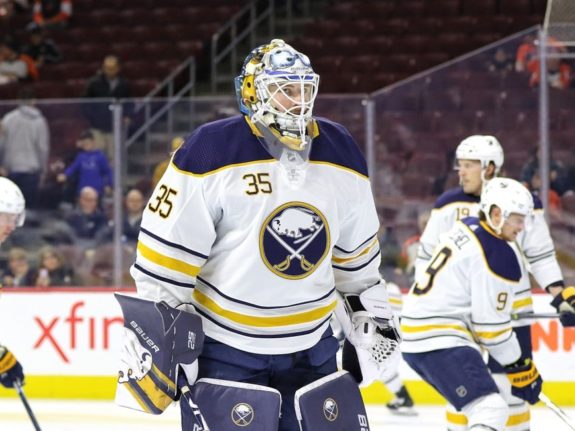
Adding to that pressure, the Sabres will have goaltender Ukko-Pekka Luukkonen playing down the road in Rochester. Sabres fans are anxious to watch him play, coming off of his OHL Goaltender of the Year award. If he has an exceptional year with the Americans and Ullmark falters, Luukkonen might see himself sharing an NHL crease as soon as 2020-21, even if that’s not the plan.
Sabres Season Screams Intrigue
We might be anticipating the puck dropping on the 50th season of Sabres hockey, but it is with mixed emotions. Sabres fans are jaded. So many losses takes a toll. No other fanbase has had to endure what Sabres fans have over the last decade.
There are reasons for optimism, or at least intrigue, looking ahead to October. Foremost among them is Krueger. Will he implement the changes needed to produce a winner? Will his Sabres flop and flounder their way to the bottom of the standings once again?
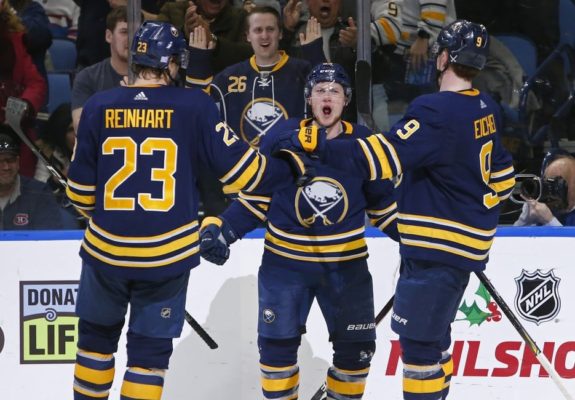
A number of Sabres are in a contract year. These seasons are approached cautiously, as their production cannot always be trusted but Sabres fans aren’t looking for trustworthy production. They need a winner. Can Reinhart, Sheary, Jimmy Vesey, Mittelstadt, Ullmark and others use their uncertain situations to cash in on massive seasons and win the Sabres a playoff spot?
It’s about time the Sabres won something.